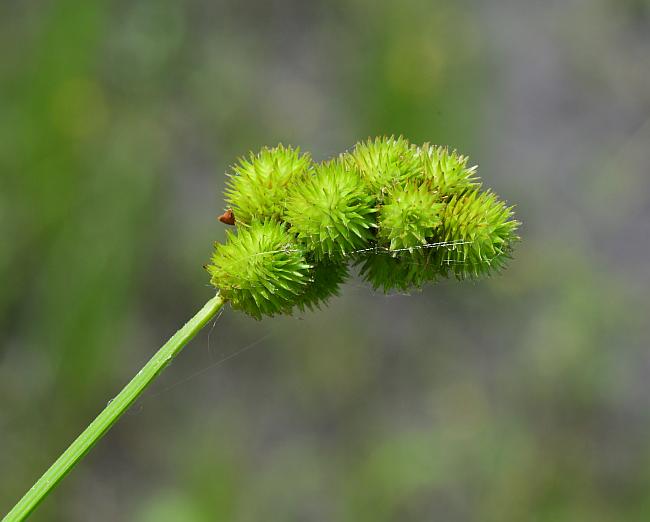Carex cristatella Britton & A. Br.
Crested Sedge

Native
CC = 4
CW = -3
MOC = 45
© SRTurner
Carex cristatella Britton & A. Br.Crested Sedge | |
 |
Native CC = 4 CW = -3 MOC = 45 |
© SRTurner |
|
Family - Cyperaceae Habit - Sedge with short rhizomes, forming clumps. Stems - Vegetative stems abundant at flowering time, conspicuous and nearly as long as the flowering stems, the leaves well spaced along the apical half. Flowering stems 30-100 cm long, usually longer than the leaves.
Leaves - Those with well developed leaves mostly 4-6 per flowering stem. Blades 2-40 cm long, 3-7 mm wide, green to yellowish green. Leaf sheaths extended past the insertion point of the leaf blade, the ventral side green nearly to the concave tip, the ligule longer than wide and U-shaped.
Inflorescence - Straight or nearly so, the 6-12 spikes mostly densely overlapping along the axis. Spikes 4-8 mm long, 4-8 mm wide, the pistillate portion circular in outline, rounded at the tip, with numerous dense perigynia with the tips spreading stiffly in all directions, the spike appearing as a spiny ball, the short staminate portion inconspicuous. Scales 1.4-1.9 mm long, much shorter and narrower than and mostly hidden by the perigynia, lanceolate to narrowly ovate, sharply pointed or tapered to a narrow point, greenish white to straw-colored, with a green midrib and lighter margins.
Perigynia - Perigynia 2.4-3.9 mm long, 1.1-1.5 mm wide, 2.5-3.0 times as long as wide, flat or nearly so on the ventral side and convex over the fruit on the dorsal side, the main body 1.3-1.9 times as long as wide, lanceolate, widest near the middle, the distance from the tip of the fruit to the tip of the perigynium 0.8-2.2 mm, narrowly winged, the wing tapered abruptly from about the middle of the main body and often ending above the base, tapered gradually to a beak with toothed or roughened margins, the wing ending more or less at the tip of the beak, the ventral and dorsal surfaces lacking papillae, finely 5-9-nerved, light green to pale brown or straw-colored.
Fruits - Achenes 1.4-1.9 mm long, 0.5-0.8 mm wide, narrowly oblong-ovate in outline, light brown. Flowering - May - July. Habitat - Bottomland prairies, moist depressions of upland prairies, sloughs, pond margins, streambanks, moist pastures, railroads, ditches. Origin - Native to the U.S. Lookalikes - Other species of Carex, particularly C. molesta and C. tribuloides. Other info. - This sedge is found in Missouri predominantly north of the Missouri River. Missouri lies near the southern edge of the plant's natural range, which extends throughout the upper Midwest and New England and into Canada. The sedge is identified by its crowded inflorescences, with each spike being dome-shaped to nearly spherical and having perigynia pointed in all directions. The spikes thus resemble spiny balls. The pistillate scales are mostly hidden by the perigynia and difficult to observe. The staminate region of the inflorescence lies at the bases of the lowermost spikes, and is very inconspicuous. Species of sedge in the section Ovales can be very difficult to identify confidently without extensive experience and a crystal ball. Photographs taken at Marais Temps Clair Conservation Area, St. Charles County, MO, 5-31-2021 (SRTurner). |